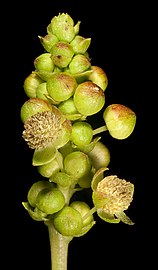
Eremophila latrobei, commonly known as crimson turkey bush, native fuchsia, Latrobe's emu bush, grey fuchsia bush, warty fuchsia bush and Georgina poison bush is a flowering plant in the figwort family, Scrophulariaceae and is endemic to Australia. It is an erect, highly branched shrub with usually linear leaves and red to purple-red flowers and which occurs in all mainland states, including the Northern Territory but excluding Victoria.
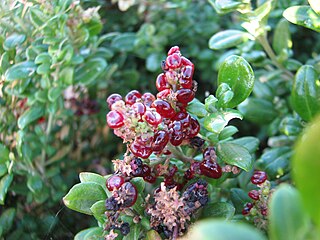
Chenopodium candolleanum, commonly known as seaberry saltbush, is a shrub in the subfamily Chenopodioideae of the family Amaranthaceae, native to Australia.
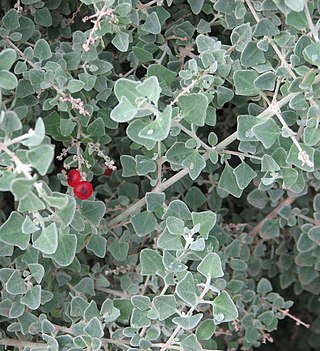
Chenopodium curvispicatum is a species of plant in the family Amaranthaceae, endemic to Australia.

Lasiopetalum behrii, commonly known as the pink velvet bush, is a species of flowering plant in the family Malvaceae and is endemic to southern continental Australia. It is an erect shrub with lance-shaped, narrowly oblong to narrowly elliptic leaves and groups of white to pink and reddish-brown flowers.

Acacia howittii, commonly known as sticky wattle or Howitt's wattle, is a tree species that is endemic to Victoria, Australia.
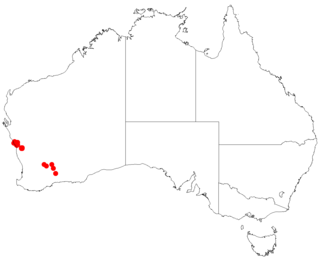
Styphelia marginata, commonly known as thick-margined leucopogon, is a species of flowering plant in the heath family Ericaceae and is endemic to the south-west of Western Australia. It is a dwarf shrub with lance-shaped leaves and white, tube-shaped flowers.

Grevillea callichlaena, commonly known as Mt. Benambra grevillea, is a species of flowering plant in the family Proteaceae and is endemic to a restricted part of Victoria in Australia. It is a spreading shrub with elliptic, egg-shaped or broadly lance-shaped leaves, and uniformly red flowers.

Olearia suffruticosa, commonly known as clustered daisy-bush, is a species of flowering plant in the family Asteraceae and is endemic to south-eastern continental Australia. It is a shrub or undershrub with scattered, linear, grass-like leaves and pink to white and yellow and pink, daisy-like inflorescences.
Grevillea nematophylla, commonly known as water bush or silver-leaved water bush, is a species of flowering plant in the family Proteaceae and is endemic to Australia. It is shrub or small tree with simple or pinnatisect leaves, the leaves or lobes linear, and branched, cylindrical clusters of cream-coloured flowers.
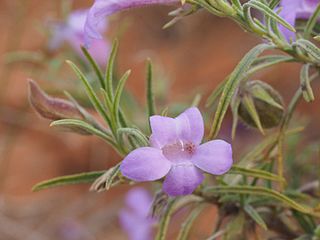
Eremophila gilesii, commonly known Charleville turkey bush, green turkey bush, desert fuchsia and Giles emu bush is a flowering plant in the figwort family, Scrophulariaceae and is endemic to Australia. It is usually a low, spreading shrub with pinkish-lilac to purple flowers and is widespread in the Northern Territory and all mainland states except Victoria. It is considered a difficult agricultural weed in some parts of Queensland but is often used as a bush medicine by Aboriginal people.
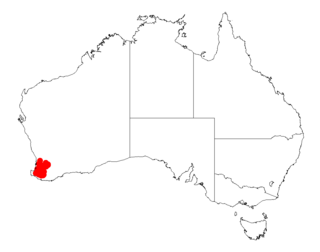
Acacia insolita is a shrub belonging to the genus Acacia and the subgenus Phyllodineae that is endemic to south western Australia.

Hakea rhombales, commonly known as walukara, is a shrub in the family Proteacea. It has red, pink or purple flowers and is endemic to Western Australia and the Northern Territory.

Olearia pannosa, commonly known as silver-leaved daisy or velvet daisy-bush, is a species of flowering plant in the family Asteraceae and is endemic to south-eastern continental Australia. It is a spreading undershrub or shrub with egg-shaped or heart-shaped leaves, and white and yellow daisy flowers.
Hibbertia crispula, commonly known as Ooldea guinea flower, is a species of flowering plant in the family Dilleniaceae and is native to disjunct locations in Western Australia and South Australia. It is a small, wiry, glabrous shrub with needle-shaped leaves and yellow flowers with twenty-five to thirty-five stamens arranged around three glabrous carpels.

Acacia glandulicarpa, commonly known as the hairy-pod wattle, is a perennial shrub belonging to the genus Acacia and the subgenus Phyllodinea that is native to parts of south eastern Australia.

Protea pendula, also known as the nodding sugarbush or arid sugarbush, is a flowering plant of the genus Protea, in the family Proteaceae, which is only found growing in the wild in the Cape Region of South Africa. In the Afrikaans language it is known as knikkopsuikerbossie or ondersteboknopprotea.
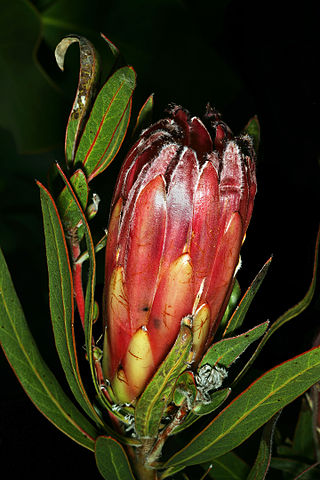
Protea burchellii, also known as Burchell's sugarbush, is a flowering shrub in the genus Protea, which is endemic to the southwestern Cape Region of South Africa.
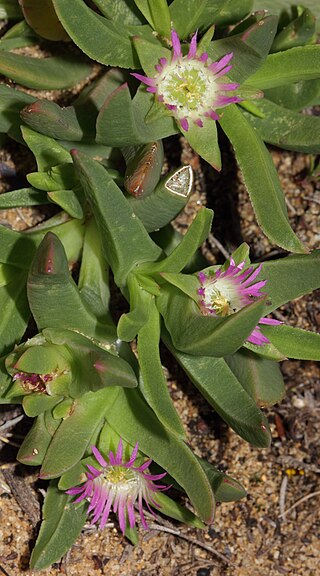
Sarcozona bicarinata, commonly known as ridged noon-flower, is species of flowering plant in the family Aizoaceae and is endemic to Australia. It is a small shrub with leaves that are triangular in cross-section and arranged in opposite pairs, and daisy-like flowers with twenty to fifty-five petal-like staminodes and twenty to fifty stamens.

Styphelia exarrhena, commonly known as desert styphelia, is a species of flowering plant in the heath family Ericaceae and is endemic to southern continental Australia. It is an erect shrub with erect or spreading egg-shaped leaves, and cream-coloured, tube-shaped flowers arranged singly or in pairs in upper leaf axils.

Acrothamnus montanus, also known as snow beard heath, is a native Australian bushy shrub commonly found in sub-alpine to alpine areas of southeast Australia.


